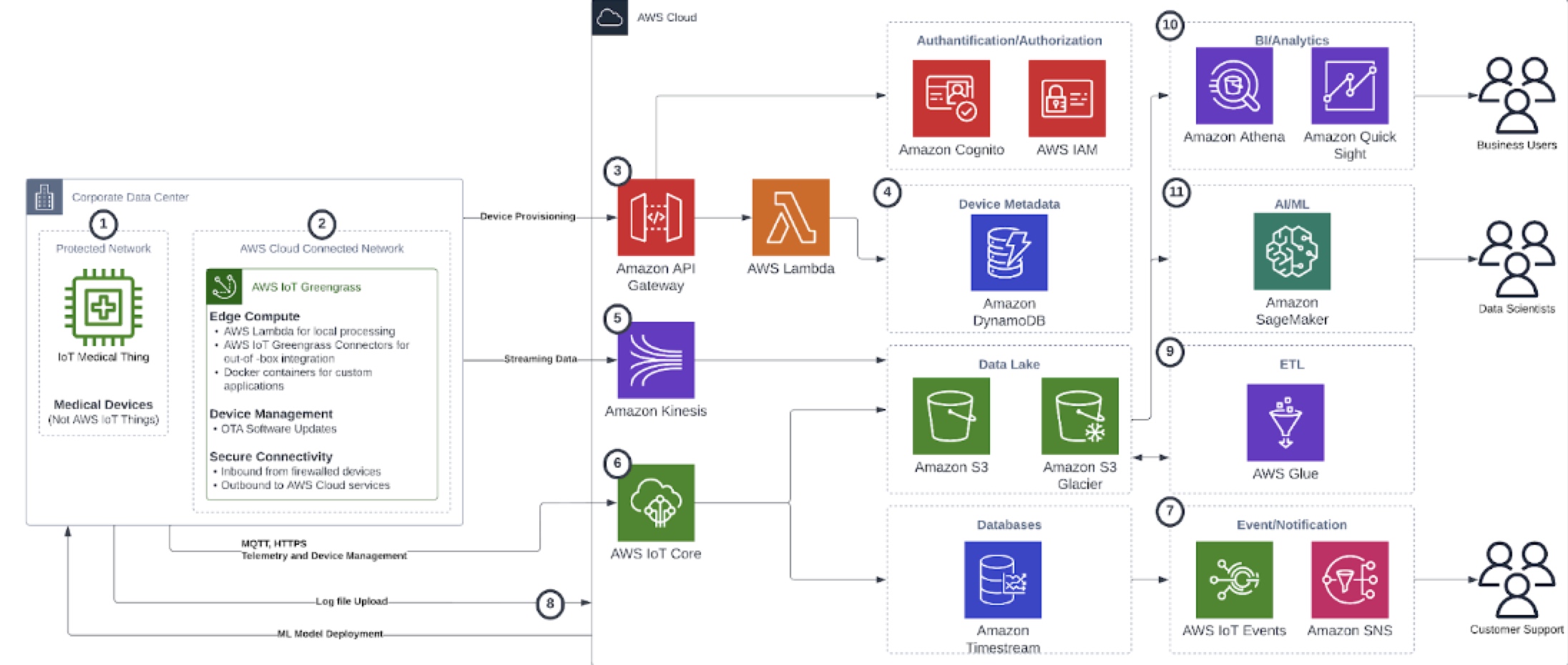The Internet of Medical Things (IoMT) refers to the network of medical devices, software, and systems that are connected to the Internet and capable of exchanging data. These devices can range from wearable fitness trackers and smartwatches to advanced medical equipment like imaging machines and surgical robots.
The IoMT has the potential to revolutionize healthcare by enabling the remote monitoring and management of patient health, improving the efficiency and accuracy of diagnoses, and providing real-time data to healthcare providers. By leveraging the AWS Cloud, healthcare organizations can build scalable and secure IoMT solutions that accelerate patient outcomes and improve the quality of care.
You can also read this article republished on our Medium.
One example of an IoMT solution on the AWS Cloud is a remote patient monitoring system. This type of system allows healthcare providers to remotely monitor patients’ vital signs and health status in real-time. By collecting data from wearable devices and other sensors, healthcare providers can identify potential issues early on and intervene before they become serious.
Another example is the use of machine learning algorithms to analyze large amounts of patient data and identify patterns and trends that can help predict and prevent diseases. By training machine learning models on the AWS Cloud, healthcare organizations can quickly and efficiently analyze data from a variety of sources including electronic health records, wearable devices, and imaging scans. At the same time, organizations must be aware of adhering to regulatory compliances like HIPAA and other data privacy regulations. Here is where the AWS suite of tools and services provides an answer.
In addition to these benefits, the AWS Cloud offers several key features that make it well-suited for building IoMT solutions. These include:
- Scalability: The AWS Cloud allows healthcare organizations to quickly and easily scale their IoMT solutions to meet the changing needs of their patients and providers.
- Security: The AWS Cloud provides a secure and compliant platform for storing and processing sensitive patient data, ensuring that it is protected from unauthorized access.
- Integration: The AWS Cloud offers a wide range of tools and services that can be easily integrated into IoMT solutions including machine learning algorithms, analytics tools, and connectivity options.
The following section looks at how the AWS reference architecture plans for Connected Medical Devices with AWS IoT.
Connected Medical Devices with AWS IoT
Regulatory compliances are critical in healthcare. In the case of HIPAA compliance, all protected health information (PHI) and personally identifiable information (PII) data need to be redacted from logs and data sent from on-premises and related applications to the cloud.
AWS CloudTrail and Amazon CloudWatch are recommended in the architecture for audibility and traceability regulatory requirements. AWS CloudTrail provides enhanced visibility into user activity by recording actions on an account, and Amazon CloudWatch, on the other hand, enables you to monitor your complete stack and uses logs, alarms, and events data to take automated actions reducing the mean time to resolution (MTTR).

You can find the corresponding details in reference to the diagram steps.
- In keeping the focus on security aspects as primary, the medical devices deployed in hospital and clinical networks work without internet connectivity. Aside from this, they can only do outbound communication to edge gateway running AWS IoT Greengrass – which is an IoT open-source edge runtime and cloud service to build, deploy, and manage device software.
- The edge gateway proxies medical devices and runs local applications on behalf of technicians for command and control. Only AWS IoT Greengrass cores are created as things in AWS IoT Core. Metadata for medical devices live in DynamoDB and not in AWS IoT Core because command and control are not allowed from the cloud.
- The AWS IoT Greengrass invokes the Amazon API Gateway as the single secure endpoint for API calls. Various APIs include those for device provisioning, accessing AWS services, and third-party endpoints.
- Amazon DynamoDB is a centralized storage for metadata, security certificates, and device models and is associated with the edge gateway that has connected medical devices.
- Medical devices generate streaming data that gets sent to Amazon Kinesis in the AWS Cloud and persists in the Amazon Simple Storage Service (Amazon S3) data lake. One can have implementation options for data and video insight by linking with device metadata in Amazon DynamoDB.
- The telemetry data from various devices sent from AWS IoT Greengrass to AWS IoT Core using MQTT can be stored in the Amazon Timestream datastore for any historical analysis.
- Telemetry data gets sent through various rules for AWS IoT Core to AWS IoT Events for complex event detection. Events that get detected create alerts for customer support through Amazon SNS.
- Data files generated as output from medical procedures are directly uploaded to Amazon S3 and linked with all the device metadata in Amazon DynamoDB. The data files can be used for artificial intelligence/machine learning (AI/ML).
- The batch extract, transform, and load (ETL) processing on data is done using AWS Glue. Curated data persists back in Amazon S3.
- Amazon Athena and Amazon QuickSight- a business analytics service help provide business intelligence (BI) visualization for the users.
- Machine learning models are trained with Amazon S3 data for analytics activities like predictive maintenance , computer vision, and others.
Wrapping everything up
Overall, the AWS Cloud provides a powerful and flexible platform for building IoMT solutions that can accelerate patient outcomes and improve the quality of care. By leveraging the scalability, security, and integration capabilities of the AWS Cloud, healthcare organizations can create innovative and effective solutions that transform the way they deliver care to their patients.







